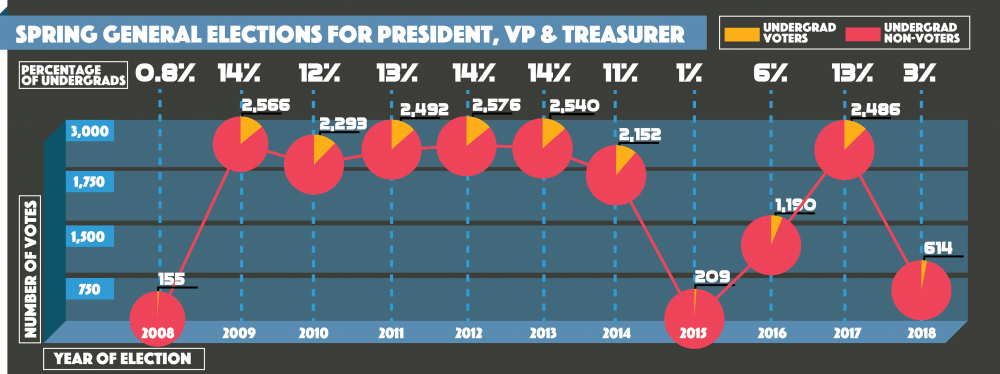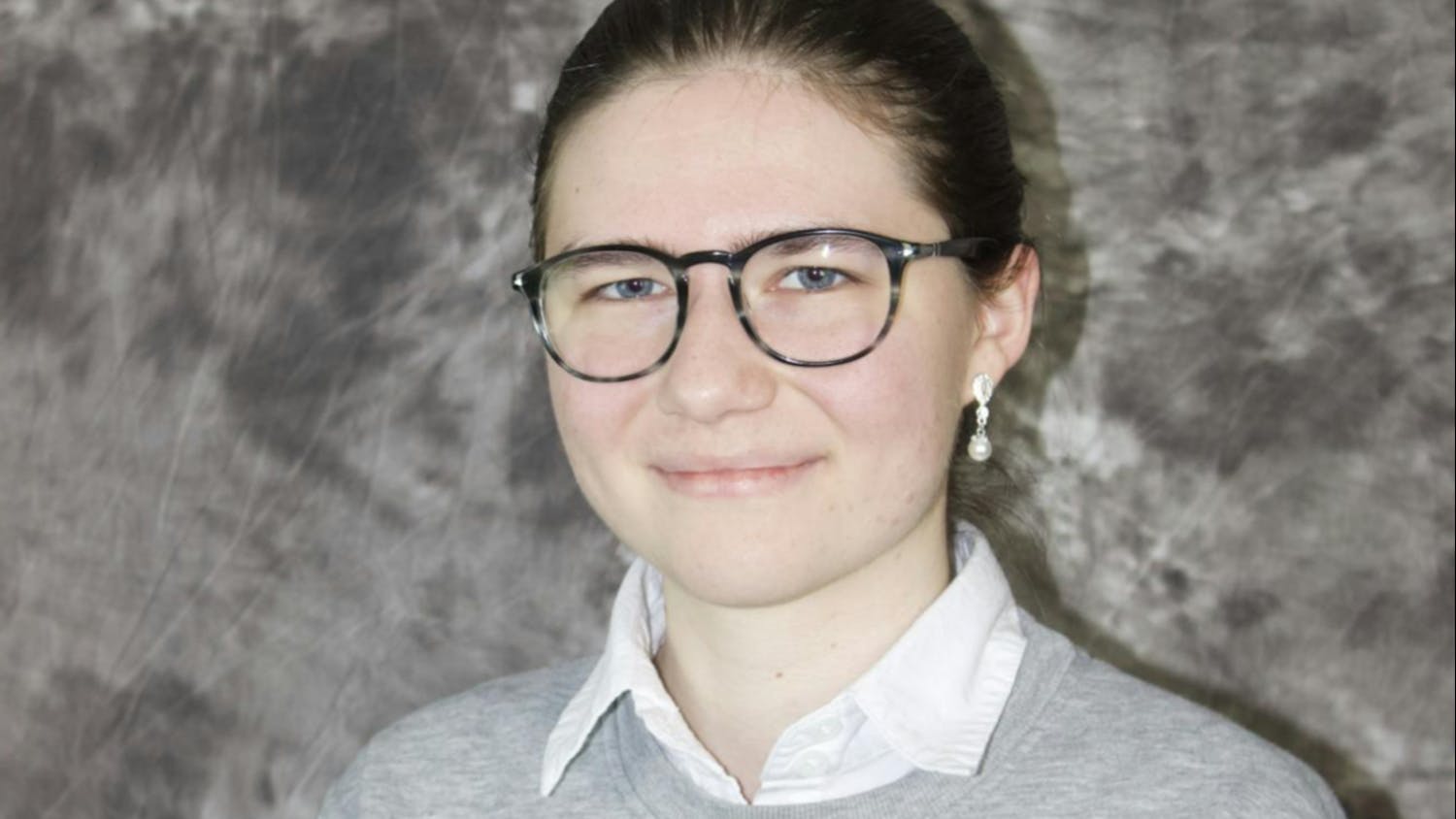Ninety-three out of every 100 students likely won’t walk into the Student Union Theater and vote on who controls their money, according to SA election statistics.
And the trend of low voter participation is getting worse. Over the last 11 years, the undergraduate student population has increased, but participation in student government and representative elections has decreased.
The Spectrum conducted a survey about participation in student government and found that many full-time students have no idea who controls the $104.75 mandatory student activity fee they pay every semester and don’t understand how it’s spent. Those same students, however, often said they care about the events held by the Student Association, the official student government of undergraduates on campus.
The Spectrum’s survey and SA statistics indicate a culture of apathy on campus and low accountability for the students in charge of their peers’ fees. Candidates often run unopposed for important budgetary positions and can essentially vote themselves into office. SA officials and professors who study politics and marketing acknowledge that the phenomenon is a problem, and at least one other large SUNY school appears to have a more engaged student body.
“There’s a pretty high apathy toward student government because UB is a commuter campus and a lot of people don’t really know much about the major issues that our student government works on and addresses,” said Mike Brown, the student representative on the UB Council, the primary oversight and advisory body to the university. “We’re generally a society, especially at an institution where students are typically here for four years, that thinks our vote doesn’t matter. That’s definitely a pervasive trend throughout the student body in general.”
This semester, 19,080 full-time students paid the mandatory student activity fee, totaling roughly $2 million, but an average of only 1,305 students have voted in the fall referendum vote and an average of 1,752 students have voted in SA’s spring election over the last 11 years.
Nine percent of 19,028 undergraduate students voted in the 2008 Senate election, but only 4 percent of 21,607 students voted in 2018.
This lack of interest has become the norm for the organization that is meant to represent the entire undergraduate student body.
A lack of interest
The Spectrum’s survey found that out of 228 students, 54 percent said they knew about SA and its responsibilities and 63 percent said they care about SA.
Only one student could name the current SA president, vice president and treasurer.
In The Spectrum’s survey, 27 percent of surveyed students said they knew what the referendum vote is and 6 percent said they voted in the referendum in 2018. The referendum asks students every two years if the activity fee should remain mandatory, and often asks students to approve an increase to the fee, as well. The referendum has never been rejected over the past 11 years.
Jahlil Wyatt, a sophomore undecided major, didn’t vote in last spring’s e-board election or the Senate election and referendum vote last month. The e-board consists of the SA president, vice president and treasurer. SA senators oversee the organization’s budget. Wyatt said a lot of students, including himself, don’t know about opportunities to have their voices heard on campus.
“I don’t think these elections are advertised in a way that lets all of the undergraduate students know about them,” Wyatt said. “If only a fraction of the student body is voting, I feel like that’s an inaccurate representation of what students want. Candidates should be out talking to students so we know who we’re voting for. If they don’t, I feel like the people that get elected spend money on things that they want, not what students actually want.”
SA President Gunnar Haberl said he worries about the lack of student interest in getting involved in student government and caring about issues on campus. He recognizes the downhill trend in student involvement on campus and said despite SA’s efforts to advertise student government, students don’t care.
“We can’t even get students to follow us on social media,” Haberl said. “We put quarter sheets throughout all the lecture halls, but people just throw them on the ground. We tried using posters, but bulletin boards get flooded and it’s a waste of paper and ink. I advertise elections in emails to SA clubs and my monthly student-wide email, but let’s be honest, students read the first couple paragraphs and delete it.”
Haberl said what’s even more concerning is that students don’t know who their e-board members are. He said he and his colleagues have been present throughout the year at orientation, football games and SA-sponsored events, so he expected more students to be familiar with them by now.
“I can understand why students might not know Anyssa’s or Tanahiry’s name because they’re not getting an email from them monthly,” Haberl said. “Unless they’re in a club, they wouldn’t deal with Anyssa, and Tanahiry isn’t the voice of SA … But for students who get an email from me once a month in which I sign it ‘President of SA,’ it’s disappointing that only 15 out of 228 students knew my name.”
Political science professor James Campbell said, one explanation of the disconnect between students and the student government is a lack of communication. He said, often times, students have no idea what candidates’ platforms are campaigning for. If students don’t know what benefits each party is promising, they likely don’t care, he said.
“I think a lot of students don’t have real opinions to express at the ballot box,” Campbell said. “In student government elections, there’s a lack of clarity as to what’s at stake, key issues and key differences are between candidates … [If a party has] no competition, why would anyone outside pay any attention to this? That’s the missing ingredient. Why should anyone pay any attention?”
Campbell said there is a correlation between the exceptionally low voter turnout during years when parties ran unopposed because as long as each student received one vote –– which could be cast by themselves –– they were elected. Without the competition of an election and a battle of ideals to interest students, they have no reason to come out and vote.
In the SA election last spring, Haberl’s R.E.A.L. party ran unopposed and only 614 students –– 3 percent of the undergraduate population –– voted, according to SA election statistics. This was the third time in SA history that an e-board ran unopposed, with each single-party election happening in the past 10 years.
Comparison within SUNY
The University at Albany, one of SUNY’s four university centers like UB, also has a Student Association that represents its undergraduate students. It holds e-board elections in the spring and had a total population of roughly 20,000 students and an undergraduate population of roughly 13,000 students in 2017. UB has roughly 30,000 undergraduate students with roughly 20,000 being undergraduates.
The major difference is that UAlbany’s voting numbers have gone up. Over the past five years, UAlbany has had an average voter turnout of 16 percent compared to UB’s 7 percent. UAlbany had its strongest voter turnout in 2018 with 20 percent of the undergrad population voting in the election. UB had 3 percent of undergraduates vote in 2018, when the R.E.A.L. party ran unopposed.
UB marketing professor Debabrata Talukdar said it’s concerning when any population can’t create an interest in getting candidates to run.
“You must sell policy based on the differences of the candidates,” Talukdar said. “I know young people feel they are too busy and have no time but it falls on the SA to interest students. They must show their importance to students while making them realize how it affects them. That allows them to see the vote as change or improvement in their lives.”
Last month, only 966 students voted in SA Senate elections and 931 voted in the bi-annual referendum, which asked students to support a $4.25 increase to the activity fee. Nine percent of 19,028 undergraduate students voted in the 2008 Senate election, but only 4 percent of 21,607 students voted in 2018.
UAlbany –– also a commuter school –– had 14 percent of its student body vote in its referendum vote this past spring.
At UB, the 12-person Senate, in charge of SA’s $3.6 million budget, only had nine students run for election this year. They all ran unopposed. Haberl will appoint three students to fill the Senate. UAlbany has multiple candidates run for different positions in its Senate, with none running unopposed in the past five years.
Talukdar said that any voting percentage below 50 percent shows a “subjection to minority opinion.” It is a situation where a select few can dictate policy without having to consider the majority opinion. Talukdar said the solution is to get students to see their votes as a voice.
“I know it is difficult trying to convince a young population to vote,” Talukdar said. “But the only way you can get people to vote is to show them that in a democratic society like ours, the best way to have your voice heard is to vote.”
Brown said UB is largely a commuter campus, creating a sense of indifference for students living off-campus who might not follow the student government.
Only 2 percent of all UB students voted to elect the student representative to the UB Council last spring. That’s an increase from the 0.1 percent of the student body that voted in the election in 2015.
UAlbany had 7 percent of its overall student population vote in its University Council Representative election in 2018.
Talukdar said the driving force to young people not voting is the idea that they “don’t have the time.” Talukdar said it is common, no matter the election, for young citizens to think they are too busy to bother or pay attention to governing bodies.
“Young people are never that busy,” Talukdar said. “What it comes down to is convience. If a student thinks it takes too much time to care about something then they will not do it. The more of a hassle it is to even know what the student government really does, the less people will know what it is.”
What can be done
In the 2016 presidential election, only 46.1 percent of adults age 18 to 29 voted, according to the U.S. Census. Campbell said in an era when less than half of college-aged adults are voting in national elections, it’s a grim reality that many probably don’t care about student elections, either.
Campbell said the main issue causing the disconnect between SA and the undergraduate student body is a lack of clarity and interest. If candidates are making themselves present on campus and interacting with students, they’re more likely to earn votes. But if they’re invisible besides for campaigning to SA clubs which may already be familiar with the candidates, students won’t feel motivated to vote.
Another reason students might not be interested in student elections is because voting for SA’s elections only takes place on North Campus. This creates a barrier for students living on or near South Campus or the downtown campus to access voting booths.
Brown said voting for his position is online, making it more accessible for students who wish to vote. Brown said he’s talked with SA professional staff about moving SA elections and votes online or adding additional booths on South Campus or in the dorms.
“The lack of other voting booths disenfranchises students who don’t live on North Campus. Why would they travel all the way to another campus if they don’t even know anything about the candidates who are running?” Brown said. “We tried to get booths on South Campus but encountered a lot of barriers. I think moving the vote to an online platform and sending out emails to the entire student body reminding them to vote would be extremely beneficial.”
There are situations with voting on campus that could be quickly fixed and help with voter turnout, Talukdar said.
“It is concerning that there is no place to vote on South Campus,” Talukdar said. “These are low-bearing fruit that UB could easily take advantage of. Having a place to vote on South would go a long way while also having multiple voting outlets on campus. North alone is a large space and it would benefit voting having polls in more than just one spot in the SU. Many students probably will never see the polls if they are just in one place, especially those on South.”
Talukdar said having the election solely in the SU Theater will not generate a high turnout. Instead, he suggested, Student Association representatives need to connect with students in multiple locations on campus.
“They could have forums during voting season where candidates are across campus having conversations with both students and other candidates,” Talukdar said. “There needs to be more than just one or two lecture hall discussions, more opportunities to let candidates listen to students and let them know their ideas are heard. They must let students know they are being heard, not just solely letting others know their opinions.”
Talukdar said that as long as voter participation stays low, the disconnect between what students want and what the SA does will always be there.
Haberl said he’s not sure how to interest more students with the resources he currently has. He thinks students need to follow SA more closely, including their social media presence and events occuring on campus.
“When does it become a lack of us trying to promote things like student government elections versus us as students taking ownership for getting the information and reading the information for ourselves?” Haberl said.
If there’s one thing he could change, Haberl said it would be unlimited student-wide emails so he could send out emails specifically pertaining to the election. Haberl is currently limited by university policy to sending one student-wide email a month.
“I think it would be beneficial, if during the campaigning process, that candidates’ platforms were sent out to all students. Maybe like a ‘get to know your candidates’ page on SA’s website,” Haberl said. “Then as SA president, I could include a link to that site in my student-wide emails to get the word out there.”
Max Kalnitz and Thomas Zafonte are senior editors and can be reached at max.kalnitz@ubspectrum.com and thomas.zafonte@ubspectrum.com , and on Twitter @Max_Kalnitz
Thomas Zafonte is a senior English major. He is a UB sports fan and enjoys traveling around Buffalo.






